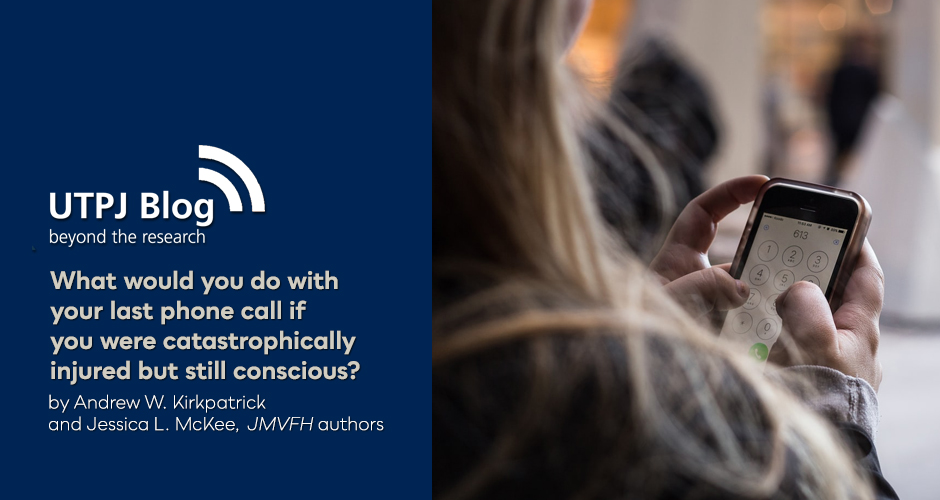
Written by guest bloggers Maj. Andrew W. Kirkpatrick and Jessica L. McKee.
This is the question that the TeleMentored Ultrasound Supported Medical Interventions (TMUSMI) Research Group tried to address in our article entitled, “Empowering catastrophic far-forward self-care: Nobody should die alone without trying1”. I am a trauma surgeon, among other things, and I typically see the belongings of my trauma patients, who both live and die in a plastic bag with their other personal belongings on a table next to the trauma stretcher in the trauma bay to be hopefully delivered to their family for safekeeping. Invariably, there is a smartphone in that bag. Most adults in our Society carry a powerful computing device, with nearly unlimited communication potential in their hands, pockets, or purses, including when they suffer a catastrophic injury. Smartphones typically allow two-way real time video and audio communication almost anywhere in the world. Hopefully the only calls people will make in their lives are happy or productive ones, to friends, colleagues, and business associates in good times. But, what about in a catastrophe?
Such a catastrophe that strikes all too often is trauma injury. Traumatic injury is an unappreciated epidemic in our society that strikes the healthiest in their prime and constitutes the leading cause of potentially preventable lost years of life. As a generalization (with tragic exceptions), cancer and heart disease leave grandchildren and endowments, but traumatic injury leaves orphans and mortgage foreclosures. For over 20 years, TMUSMI has been learning about how to guide inexperienced potential caregivers to perform outside their traditional scope, through remote guidance using off the shelf communication technologies. Spinning off a paradigm first created to provide diagnoses and care to astronauts onboard the International Space Station2, we examined real-time ultrasound guidance between a big city trauma centre and a rural referral centre in the Rocky Mountains3. Although the interactions worked well, they were not sustainable, as urgent trauma care requires just that – urgency. Any guidance tool intended for real-world use in trauma must be instantaneous or it is too long for a dying patient to wait. Thus, we introduced real-time teleultrasound conducted over an iPhone4, and subsequently have tried to show that almost anyone can be guided from anywhere with a smartphone if they have reliable internet5-6.
Throughout nearly 20 years of research, we have continually been amazed by the resourcefulness and adaptability of intelligent and motivated novices, as well as continually disappointed with the predictable limitations of technical expert physicians regarding their ability to guide non-physicians due to communication challenges. Upon reflection, we now believe that this reflects a lack of training and thus we recommend that learning how to remotely guide others to excel in delivering medical care at a distance should be a fully distinct and recognized medical specialty7.
Recently, catalyzed by our Pandemic induced need for self-isolation, we explored the potential to examine the ultimate in patient involvement in their health care AND complete self isolation. We again have been amazed at the proficiency with which untrained but willing and motivated persons can follow real-time advice to obtain high-quality, self-diagnostic images under remote guidance8-9). This is the premise behind our article’s discussion of how we may be able to remotely guide people to save themselves when no one else will. Currently, this is theoretical, but TMUSMI hopes to be able to report real data and experiences in the near future.
About the Authors
 Maj. Andrew W. Kirkpatrick, MD, MHSc, CD, FACS, is a professor of surgery and critical care medicine at the University of Calgary and has written 500 peer-reviewed manuscripts and book chapters. He is also the principal investigator of the Closed or Open after Laparotomy for Severe Intra-Abdominal Sepsis Trial and Director of the TeleMedical Ultrasound Supported Medical Interventions (TMUSMI) Research Group. He is a member of the Canadian Armed Forces and former paratrooper with multiple overseas deployments.
Maj. Andrew W. Kirkpatrick, MD, MHSc, CD, FACS, is a professor of surgery and critical care medicine at the University of Calgary and has written 500 peer-reviewed manuscripts and book chapters. He is also the principal investigator of the Closed or Open after Laparotomy for Severe Intra-Abdominal Sepsis Trial and Director of the TeleMedical Ultrasound Supported Medical Interventions (TMUSMI) Research Group. He is a member of the Canadian Armed Forces and former paratrooper with multiple overseas deployments.
 Jessica L. McKee, BA, MSc, is a project manager for multiple critical studies, including the TeleMedical Ultrasound Supported Medical Interventions Research Group and the global trial manager of the Closed or Open after Laparotomy for Severe Intra-Abdominal Sepsis Trial. She has written more than 45 peer-reviewed publications and is a master problem solver. She has a master’s degree in psychology and is a noted philanthropist and women’s and LGBT rights advocate.
Jessica L. McKee, BA, MSc, is a project manager for multiple critical studies, including the TeleMedical Ultrasound Supported Medical Interventions Research Group and the global trial manager of the Closed or Open after Laparotomy for Severe Intra-Abdominal Sepsis Trial. She has written more than 45 peer-reviewed publications and is a master problem solver. She has a master’s degree in psychology and is a noted philanthropist and women’s and LGBT rights advocate.
Their article, “Empowering catastrophic far-forward self-care: Nobody should die alone without trying1” was published open access in the Journal of Military, Veteran and Family Health volume 8 special issue 2 entitled Preventive medicine, operational readiness and combat casualty care for the modern military.
References
- Kirkpatrick AW, McKee JL. Empowering catastrophic far-forward self-care: Nobody should die alone without trying. J Mil Fam Vet Health. 2022;8(s2):104-114..
- Sargsyan AE, Hamilton DR, Jones JA, Melton S, Whitson PA, Kirkpatrick AW, et al. FAST at MACH 20: clinical ultrasound aboard the International Space Station. J Trauma. 2005;58(1):35-9.
- Dyer D, Cusden J, Turner C, Boyd J, Hall R, Lautner D, et al. The clinical and technical evaluation of a remote telementored telesonography system during the acute resuscitation and transfer of the injured patient. J Trauma. 2008;65(6):1209-16.
- McBeth PB, Hamilton T, Kirkpatrick AW. Cost-effective remote iPhone-teathered telementored trauma telesonography. The Journal of trauma. 2010;69(6):1597-9.
- McBeth PB, Crawford I, Blaivas M, Hamilton T, Musselwhite K, Panebianco N, et al. Simple, almost anywhere, with almost anyone: remote low-cost telementored resuscitative lung ultrasound. The Journal of trauma. 2011;71(6):1528-35.
- McBeth P, Crawford I, Tiruta C, Xiao Z, Zhu GQ, Shuster M, et al. Help is in your pocket: the potential accuracy of smartphone- and laptop-based remotely guided resuscitative telesonography. Telemedicine journal and e-health : the official journal of the American Telemedicine Association. 2013;19(12):924-30.
- Kirkpatrick AW. Point-of-care resuscitation research: From extreme to mainstream: Trauma Association of Canada Fraser Gurd Lecture 2019. J Trauma Acute Care Surg. 2019;87(3):571-81.
- Kirkpatrick AW, McKee JL, Ball CG, Ma IWY, Melniker LA. Empowering the willing: the feasibility of tele-mentored self-performed pleural ultrasound assessment for the surveillance of lung health. Ultrasound J. 2022;14(1):2.
- Kirkpatrick AW, McKee JL, Conly JM. Longitudinal remotely mentored self-performed lung ultrasound surveillance of paucisymptomatic Covid-19 patients at risk of disease progression. Ultrasound J. 2021;13(1):27.
Comments on this entry are closed.